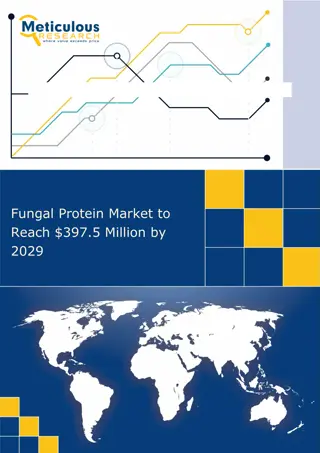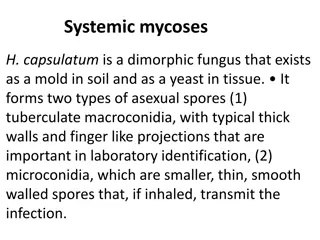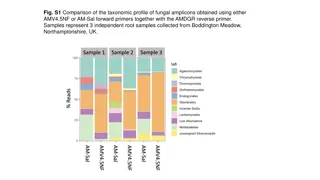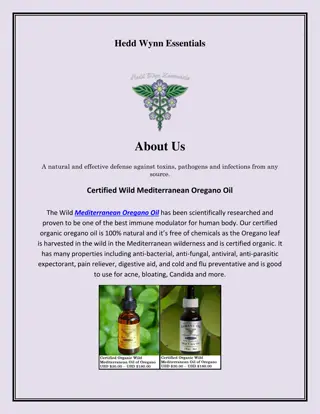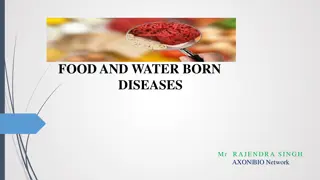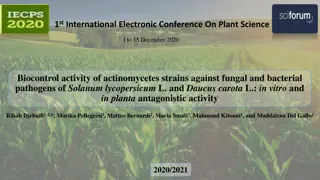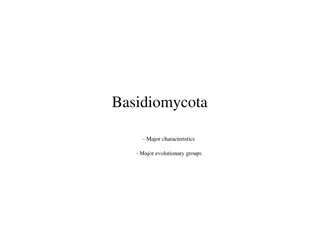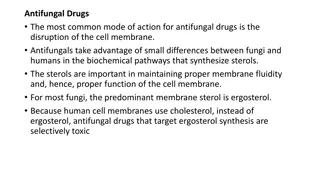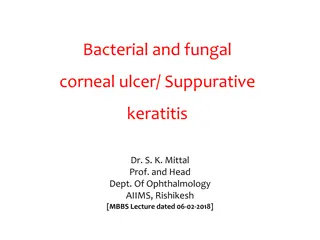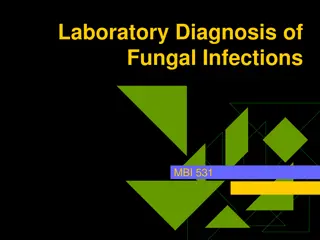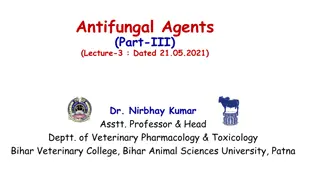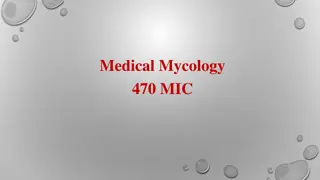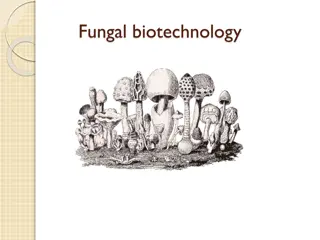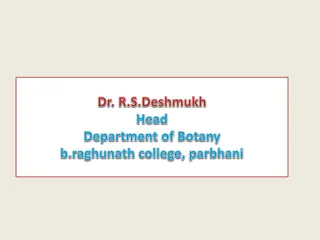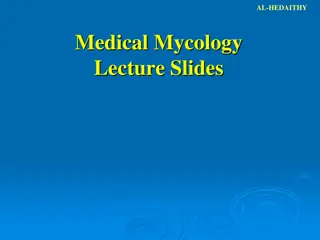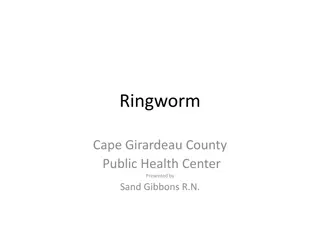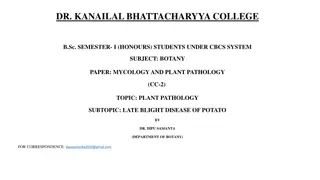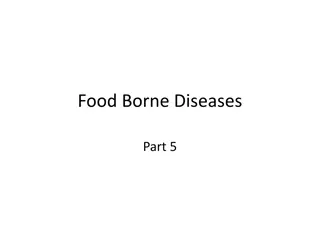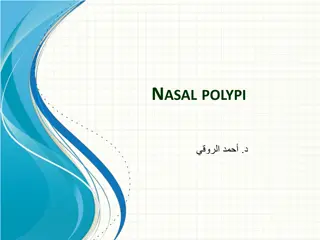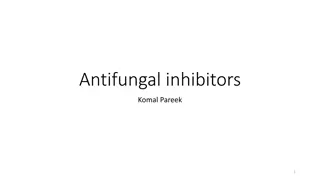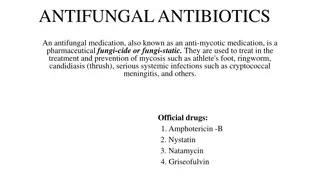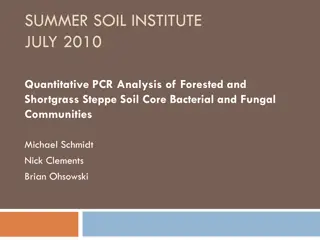Understanding Biofertilizers: Production Technology and Types
Biofertilizers are natural microbial inoculants that provide nutrients to crop plants, improve soil health, and promote sustainable agriculture. Learn about the production technology, benefits, and types of biofertilizers including bacterial, fungal, algal, and aquatic fern biofertilizers. Explore h
5 views • 13 slides
Wild Mediterranean Oregano Oil, wildoiloforegano.com (1)
It has many properties including anti-bacterial, anti-fungal, antiviral, anti-parasitic expectorant, pain reliever, digestive aid, and cold and flu preventative and is good to use for acne, bloating, Candida and more. \/\/tinyurl.com\/2bb5fas4
1 views • 2 slides
Understanding Nontuberculous Mycobacteria Infections in Cystic Fibrosis
Nontuberculous mycobacteria (NTM) infections present a significant challenge in individuals with cystic fibrosis (CF). These infections are caused by over 200 species of atypical mycobacteria found in various environments. The CF-ID Clinic plays a crucial role in managing patients with multi-drug re
2 views • 25 slides
FUNGAL SPECIES AND THEIR TOXINS.
Explore the world of fungal species and their toxins as studied by Prof. Abdullah Msaad Al-Falih at King Saud University's College of Science. Discover over 500 mycotoxins, including aflatoxins, ochratoxins, trichothecenes, fumonisins, sterigmatocystin, ergot alkaloids, zearalenone, Alternaria toxin
2 views • 8 slides
CANDIDIASIS
Candidiasis is an opportunistic fungal infection caused by Candida species. Learn about the pathogen, common infections, clinical settings, laboratory diagnosis, and treatment options associated with Candidiasis.
2 views • 33 slides
Estimation of Serious Mycoses Burden in Indonesia
This study estimates the burden of serious fungal infections in Indonesia, a country with rich biodiversity and limited medical mycology facilities. The data indicates a high prevalence of opportunistic infections in AIDS patients and TB cases, with Candidiasis and Cryptococcosis being significant c
2 views • 29 slides
Understanding Pneumonia: Causes, Classification, and Risk Factors
Pneumonia is an infection of the lower respiratory tract that can be classified anatomically and etiologically. The common causes include bacterial, viral, and fungal pathogens, as well as aspiration pneumonia. Factors such as immune deficiency, overcrowding, and poor hygiene can increase the risk o
10 views • 37 slides
Understanding Fungal Microorganisms and Their Impact on Human Health
Fungal microorganisms, including yeast and mold, play crucial roles in the human body's ecosystem. They can be both beneficial and harmful, influencing conditions like candidiasis and mycoses. Learn about the diverse forms and functions of eukaryotic organisms, their morphology, and the transition b
8 views • 33 slides
Overview of Superficial Fungal Infections of the Skin
Superficial fungal infections of the skin are categorized into superficial, cutaneous, and subcutaneous types. Superficial mycoses affect the stratum corneum and include conditions like tinea versicolor, tinea nigra, and piedra. Tinea versicolor is a chronic infection caused by Malassezia furfur, wh
3 views • 31 slides
Oregano Oil for Skin Infection, wildoiloforegano.com
Oregano also contains compounds that may be effective against bacterial and fungal infections, it helps to avoid skin infection and it is also known as antiviral medicine, for more information, visit our website and know more details about our product and price. \/\/tinyurl.com\/msr982z2
10 views • 2 slides
Forecasted: Fungal Protein Market to Surpass $397.5 Million by 2029
Explore $397.5 million fungal protein market: Get exclusive insights on key market trends, segments, geographical analysis, & competitive analysis!\n
1 views • 3 slides
Systemic mycoses
Systemic mycoses are fungal infections caused by dimorphic fungi such as Histoplasma capsulatum, Blastomyces dermatitidis, and Cryptococcus neoformans. Histoplasmosis is transmitted through inhalation of spores from soil or bat-infested caves, presenting with tuberculate macroconidia and microconidi
4 views • 9 slides
Food spoilage
In this lecture from the Department of Pathological Analyses at the University of Basrah, Prof. Dr. Saad S. Mahdi Al-amaradi Al-Amara discusses food spoilage, focusing on cereals, bakery foods, and meat products. The presentation covers the microbial spoilage of grains, including common mold species
0 views • 9 slides
Fungal Diversity Analysis in Wheat Roots Using Different Primers
Comparison of fungal taxonomic profiles in wheat roots using different primers, showcasing relative abundances of Glomeromycotina and Mucoromycotina orders in different treatments and varieties. Box plots demonstrate ASV evenness, observed ASV numbers, and Shannon diversity index, revealing insights
0 views • 5 slides
Certified Organic Oregano Oil, wildoiloforegano.com
It has many properties including anti-bacterial, anti-fungal, antiviral, anti-parasitic expectorant, pain reliever, digestive aid, and cold and flu preventative and is good to use for acne, bloating, Candida and more. https:\/\/tinyurl.com\/2bb5fas4
2 views • 2 slides
Oregano Oil for Skin Infection, wildoiloforegano.com
Oregano also contains compounds that may be effective against bacterial and fungal infections, it helps to avoid skin infection and it is also known as antiviral medicine, for more information, visit our website and know more details about our product and price. https:\/\/tinyurl.com\/msr982z2
3 views • 2 slides
Understanding Fungal and Protist Diseases: Impacts and Prevention
Fungi and protists play significant roles as pathogens, causing diseases in both humans and plants. Fungal diseases like athletes foot and protist diseases like malaria can have serious impacts on health. Control measures such as understanding symptoms, spread mechanisms, and prevention strategies a
0 views • 10 slides
Understanding Fungi Diversity and Infections in Microbiology
Explore the world of fungi and fungal infections in this foundation block of microbiology. Learn about medically important yeasts, mold fungi, major fungal diseases, antifungal agents, and infection acquisition methods. Dive into hypersensitivity reactions, mycotoxicoses, and various types of fungal
1 views • 19 slides
Understanding Mycoherbicides: Effective Weed Control Using Fungal Pathogens
Mycoherbicides are biologically based agents derived from fungi to control weeds. They are cost-effective, stable, and environmentally friendly. History shows successful experiments in using mycoherbicides to combat invasive plant species. These agents work by releasing phytotoxins that kill target
0 views • 26 slides
Understanding Food and Water-Borne Diseases: Causes and Classification
Food and water-borne diseases, caused by contaminated food or water, lead to acute illnesses. These diseases are classified into food-borne infections and food-borne intoxications. Food-borne infections, triggered by pathogenic microorganisms, can be fungal, bacterial, viral, or parasitic, with long
3 views • 57 slides
Biocontrol Activity of Actinomycetes Against Pathogens of Tomato and Carrot
Plants face various stresses due to climate change, making them vulnerable to pathogens. Actinomycetes, such as Streptomyces, are beneficial soil bacteria with antimicrobial properties that can promote plant growth and suppress diseases. Research explores their antagonistic activity against fungal a
0 views • 13 slides
Evolutionary Insights of Basidiomycota Dikaryons
Basidiomycota, a successful fungal group with 30,000 known species, predominantly exhibits filamentous vegetative growth while also producing yeast forms. The multi-layered cell wall and regularly septate hyphae with dikaryotic mycelium are key characteristics. Recent experimentation on Schizophyllu
0 views • 20 slides
Understanding Antifungal Drugs: Modes of Action and Applications
Antifungal drugs target ergosterol biosynthesis in fungi, disrupting cell membrane integrity. Imidazoles like miconazole and ketoconazole are commonly used for skin infections, while triazoles such as fluconazole treat systemic yeast infections. Allylamines inhibit ergosterol synthesis, with terbina
0 views • 13 slides
Overview of Bacterial and Fungal Corneal Ulcer
Bacterial and fungal corneal ulcers, known as suppurative keratitis, are a significant cause of blindness, included in national blindness control programs. They result from infections by exogenous organisms like S. aureus, S. pneumoniae, Aspergillus, and Candida. Predisposing factors include trauma,
0 views • 28 slides
Laboratory Diagnosis of Fungal Infections: Specimen Collection and Transport
In the laboratory diagnosis of fungal infections, proper collection and transportation of specimens are crucial for accurate diagnosis and treatment. Different sites and types of specimens require specific collection techniques to avoid contamination and ensure viability. From superficial to systemi
0 views • 29 slides
Understanding Azole Antifungal Agents for Veterinary Use
Azole antifungal agents play a crucial role in treating fungal infections in veterinary medicine. Imidazoles like clotrimazole and triazoles like fluconazole are commonly used for their fungistatic properties. These agents inhibit fungal enzymes, disrupting membrane fluidity and inhibiting cell repl
0 views • 14 slides
Key Characteristics of Fungal Divisions and Sub-Divisions
Identification key for important characteristics of fungal divisions and sub-divisions, including Myxomycota and Eumycota, with detailed descriptions of sub-divisions such as Mastigomycotina, Zygomycotina, Ascomycotina, Basidiomycotina, and Deuteromycotina. Focus on distinguishing features, reproduc
0 views • 13 slides
Impacts of Brassica Removal on Plant and Fungal Communities
Study on methods of Brassica removal in Coastal Sage Scrub ecosystems, evaluating effects on plant and fungal communities. Results show differences in vegetation cover, species composition, and fungal biomass with various removal techniques like herbicide, mowing, and hand-weeding.
0 views • 19 slides
Fungal Microbiology Laboratory Procedures
This content provides detailed guidelines on fungal culture purification, subculturing process, preparation of microscopic slides for fungal micromorphology assessment, and isolation of human samples for diagnosing fungal infections. The procedures include steps for identifying characteristics of in
1 views • 9 slides
Exploring the World of Fungal Biotechnology
Fungal biotechnology involves utilizing living organisms like fungi for industrial applications, leading to the production of various valuable products such as enzymes, vitamins, and secondary metabolites. This field not only benefits industries by offering energy-efficient processes but also contri
0 views • 15 slides
Introduction to Lichens: General Overview, Classification, and Economic Importance
Lichens are symbiotic organisms composed of fungi and algae, with the algal component synthesizing food while the fungal component provides structure. They have unique characteristics and are classified based on their fungal partner, thallus forms, and habitat. Ascolichens and Basidiolichens are two
0 views • 24 slides
Comprehensive Overview of Medical Mycology and Fungal Structures
Explore the field of medical mycology through lecture slides by AL-HEDAITHY covering various topics such as basic mycology, superficial mycoses, primary systemic mycoses, fungal structures, and reproduction in fungi. Dive into details about different fungal infections, their characteristics, forms o
0 views • 94 slides
Understanding Ringworm: Symptoms, Treatment, and Prevention
Ringworm, a common fungal infection, manifests as small, reddish, itchy patches that form ring-shaped lesions on the skin. It is contagious and can recur over many years if left untreated. Effective treatment involves anti-fungal topical creams or oral prescriptions in severe cases. Exclusion from s
0 views • 42 slides
Late Blight Disease of Potato: Symptoms and Management
Late blight is a severe fungal disease affecting potatoes worldwide, causing foliage damage, reduced tuber yield, and decay. It is caused by Phytophthora infestans and manifests as brownish-black lesions on plant parts. The disease spreads rapidly under humid conditions, leading to blighting of foli
0 views • 8 slides
Understanding Fungal Skin Infections and Eczema/Dermatitis
Learn about fungal skin infections like Athlete's foot and ways to manage them, including symptoms, treatment options, and when to seek medical attention. Additionally, explore common skin conditions such as eczema and dermatitis, their causes, and typical symptoms in this informative guide.
0 views • 34 slides
Understanding Fungal and Chemical Food-Borne Intoxications
Fungal intoxications are caused by mycotoxins produced by fungi in improperly stored food, with aflatoxicosis being a significant concern. Aflatoxins can lead to acute hemorrhagic syndromes and long-term liver tumors. Prevention strategies include proper drying and storage of foods. Chemical food-bo
0 views • 19 slides
Understanding Nasal Polypi and Their Classifications
Nasal polyps are simple oedematous growths in the nasal mucosa that can be unilateral or bilateral. They are classified into simple nasal polyps, fungal polyps, and malignant polyps. Simple nasal polypi, also known as inflammatory polyps, include ethmoidal polyps and antrochoanal polyps. Fungal poly
0 views • 18 slides
Understanding Antifungal Inhibitors and Drugs
In this detailed overview, we explore antifungal inhibitors and drugs, including their mechanisms of action, impact on eukaryotes and prokaryotes, common agents affecting fungal sterols and cell walls, as well as synthetic antifungals. From polyenes like nystatin to azoles such as voriconazole, this
0 views • 12 slides
Overview of Antifungal Antibiotics and Their Uses
Antifungal antibiotics are crucial medications used to treat and prevent various fungal infections such as athlete's foot, ringworm, candidiasis, and systemic infections like cryptococcal meningitis. This article discusses key antifungal medications including Amphotericin-B, Nystatin, Natamycin, and
0 views • 6 slides
Analysis of Bacterial and Fungal Communities in Forested and Shortgrass Steppe Soil
The study conducted in July 2010 at the Summer Soil Institute involved a Quantitative PCR analysis of bacterial and fungal communities in Forested and Shortgrass Steppe Soil. The research compared the microbial DNA extracted from different sites and depths in these ecosystems, using techniques such
0 views • 14 slides










